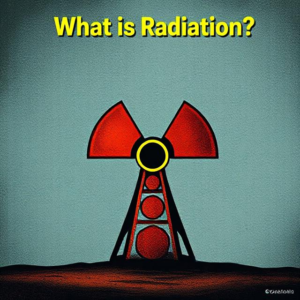Radiation: Types of Radiation (Alpha, Beta, Gamma) and Half-Life Explained Simply
Radiation is a process by which energy is emitted from a source in the form of particles or waves. You may have heard about radiation in the context of radioactive materials or nuclear reactions. In this guide, we will explain the types of radiation (alpha, beta, and gamma) and the concept of half-life in a way that’s easy to understand.

1. What is Radiation?
Radiation occurs when unstable atoms (radioactive materials) release energy to become more stable. This energy can come in the form of particles or electromagnetic waves. Radiation can be harmful or useful, depending on its type and how much exposure you get.
There are three main types of radiation that we commonly encounter:
- Alpha Radiation (α)
- Beta Radiation (β)
- Gamma Radiation (γ)
Each type has its own characteristics, properties, and effects.
2. Types of Radiation
1. Alpha Radiation (α)
- What is it?: Alpha radiation consists of alpha particles, which are made up of 2 protons and 2 neutrons (just like a helium nucleus).
- How does it behave?
- Heavy and slow: Alpha particles are large and move slowly compared to other types of radiation.
- Low penetration: Alpha particles can’t travel very far. In fact, they can be stopped by just a sheet of paper or even human skin.
- Dangerous if inhaled or ingested: While alpha particles can’t penetrate the skin, if radioactive material emitting alpha particles is swallowed or inhaled, it can be harmful to internal organs.
- Example: The element radon releases alpha radiation as it decays.
2. Beta Radiation (β)
- What is it?: Beta radiation consists of beta particles, which are high-energy electrons (beta-minus, β⁻) or positrons (beta-plus, β⁺).
- How does it behave?
- Smaller and faster than alpha particles: Beta particles are much smaller and lighter than alpha particles and can travel much farther.
- Moderate penetration: Beta particles can pass through paper but can be stopped by materials like plastic, glass, or a thin sheet of metal.
- Potential danger: Beta radiation can penetrate the outer layers of your skin, so if you’re exposed for a long time, it could be harmful.
- Example: Carbon-14, which is used in radiocarbon dating, undergoes beta decay.
3. Gamma Radiation (γ)
- What is it?: Gamma radiation consists of high-energy electromagnetic waves (like X-rays but with higher energy).
- How does it behave?
- Very penetrating: Gamma rays are the most penetrating type of radiation. They can pass through almost any material, including concrete and lead, although thicker materials are more effective at blocking them.
- No mass or charge: Gamma rays are just energy, so they don’t have mass or charge, unlike alpha and beta particles.
- Dangerous: Because gamma radiation can penetrate the body, it can be harmful to internal organs, and long-term exposure can lead to radiation sickness or cancer.
- Example: Gamma rays are often emitted during the decay of radioactive isotopes like Cobalt-60, used in medical treatments.
3. What is Half-Life?
The half-life of a radioactive substance is the time it takes for half of a sample of that substance to decay and transform into something else. It’s a measure of how quickly or slowly the substance loses its radioactivity.
Key Points About Half-Life:
- Radioactive decay is random: We cannot predict when a single atom will decay, but we can predict how long it will take for half of a large number of atoms to decay.
- The half-life is the time it takes for half of the radioactive atoms in a sample to decay. After one half-life, half of the atoms have decayed, and the other half remain. After two half-lives, only a quarter remains, and so on.
Example:
- The half-life of Carbon-14 is about 5,730 years. This means that if you start with 100 grams of Carbon-14, after 5,730 years, you’ll have 50 grams of Carbon-14 remaining, and the other 50 grams will have decayed into Nitrogen-14.
Why is Half-Life Important?
- Dating ancient objects: Scientists use the half-life of Carbon-14 to date ancient fossils, artifacts, or even human remains.
- Medical applications: Half-life is important in medicine, particularly in radiotherapy for cancer treatment, where radioactive isotopes with short half-lives are used to target cancer cells.
Summary of Types of Radiation and Half-Life
| Type of Radiation | Particle | Penetration Ability | Example | Harmful Effects |
|---|---|---|---|---|
| Alpha Radiation (α) | Alpha particle (2 protons, 2 neutrons) | Low (can be stopped by paper or skin) | Radon gas, Uranium | Harmful if inhaled or ingested |
| Beta Radiation (β) | Electron or positron | Moderate (can be stopped by plastic, glass) | Carbon-14, Strontium-90 | Can penetrate skin, causing internal damage |
| Gamma Radiation (γ) | Electromagnetic wave (high energy) | High (requires thick lead or concrete) | Cobalt-60, Uranium-238 | Can penetrate body and cause serious internal damage |
- Alpha radiation is the least penetrating but can be very harmful if inhaled or ingested.
- Beta radiation can penetrate deeper than alpha particles but can be blocked by materials like plastic or metal.
- Gamma radiation is the most penetrating and requires thick shielding like lead to protect against it.
- Half-life is the time it takes for half of the radioactive material to decay. It’s used to understand how long a substance will remain radioactive and has many applications in dating, medicine, and science.
Understanding these concepts helps us handle radioactive materials safely and use their properties for practical purposes like medical treatments and environmental monitoring.
Tags: 2 neutrons, 2 protons, alpha particles, alpha radiation, beta decay, beta particles, beta radiation, cancer treatment, carbon-14, cobalt-60, concrete shielding, decay time, Electromagnetic Waves, electrons, gamma radiation, half-life, helium nucleus, high energy, high penetration, inhalation hazard, lead shielding, low penetration, medical applications, moderate penetration, Nuclear Reactions, paper shielding, particle radiation, plastic shielding, positrons, Radiation, radiation hazards., radiation measurement, radiation protection, radiation safety, radiation sickness, radioactive contamination, Radioactive Decay, radioactive exposure, radioactive half-life, radioactive isotopes, radioactive material, radioactive sample, radiocarbon dating, radiotherapy, skin penetration, unstable atoms, uranium-238, wave radiation


